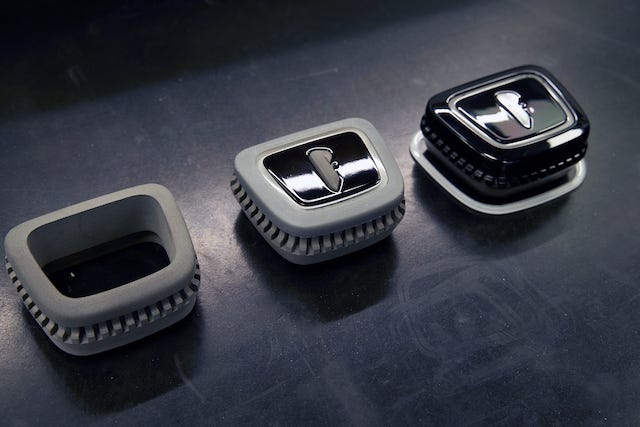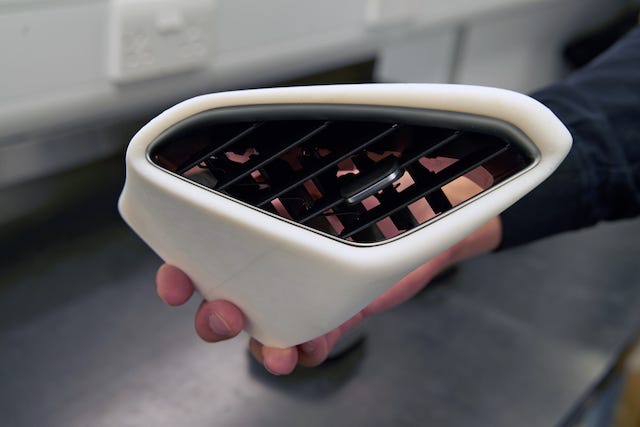How 3D Printing Is Re-Tooling Concept Car Design and Fabrication
When major automakers want to experiment and push boundaries in automotive design, they turn to Vital Auto, which turns to a well-equipped 3D printing department to realize those visions.
January 19, 2022
UK-based Vital Auto is an industrial design studio with extensive expertise in automotive projects. The company’s clientele includes many major automakers, such as Volvo, Nissan, Lotus, McLaren, Geely, and Tata.
“Clients typically come to us to try and push the boundaries of what's possible with the technology available,” said Shay Moradi, Vital’s VP of Innovation & Experiential Technology. When manufacturers don't have time for experimentation themselves, they rely on Vital Auto to turn ideas, initial sketches, drawings, or technical specifications into a fully realized physical form. One of the tools Vital Auto uses to create high-fidelity prototypes and concept cars is a fleet of Form 3L and Fuse 1 3D printers from Formlabs.
Chinese EV concept
One of the first projects the company took on was for the Chinese electric NIO EP9 supercar concept, which set the team on a course to producing extremely realistic, high-fidelity vehicle prototypes.
Depending on the client request, the team will start anywhere from a sketch on a piece of paper to an already designed vehicle. The team develops cars from a blank sheet, designs all the mainframes, all the exterior and interior elements, and interactive elements. With five to 30 people working on a single concept, a typical project could take anywhere from three to 12 months.
A typical show car goes through up to a dozen core design iterations, and within those, there can be further iterations of smaller components until the design meets the expectations of the customer.
“It's all well in our industry to look at virtual properties as a means of evaluating a product before it goes to market. However, I think there's always going to be a place for physical manufactured objects, as well. There's nothing that beats the sensation and feeling of holding an object in your hands with the correct weight and proportions, and the dynamics of how the physical environment changes your perception of that physical object,” said Moradi.
From milling clay to 3D play
While traditional show cars are normally made just from milling clay, the team also uses three- and five-axis CNC milling, hand forming, hand clay modeling, and GRP composites. These traditional processes, however, often are not ideal for producing the custom parts required for one-off concepts.
“We've used 3D printing from day one. We wanted to introduce it to our manufacturing processes, not only to reduce costs, but to give customers more diversity with their designs and their ideas,” said Anthony Barnicott, Design Engineer in charge of additive manufacturing.
|
Multi-material combinations realized via multiple 3D-printing formats. |
Today, Barnicott runs a whole 3D printing department, equipped with three Formlabs 3L large-format stereolithography (SLA) printers, five Fuse 1 selective laser sintering (SLS) printers, and 14 large-format fused deposition modeling (FDM) printers.
“In terms of capacity, all those printers have run 100%, 24/7, pretty much since day one. We use these printers for all areas of our concepts and designs. Typically, we would use the Fuse 1s for our production-based parts and our Form 3Ls for our concept-based parts,” said Barnicott.
Complex designs from multiple materials
“We use the Form 3L machines for anything that is an A-class finished surface. So, typically, in an automotive environment, an interior where you have parts that are not being trimmed with leather or Alcantara or some sort of cloth material. Formlabs materials give us a nice, smooth finish for our painters to work with; we can use these parts straight out of the printer, straight onto a vehicle,” said Barnicott.
“What interests me most about the Form 3L machines is their versatility, the ability to do a material change in less than five minutes, and the variability of those materials — going from a soft, flexible material to a hard and rigid material for us is priceless,” said Barnicott.
The team uses the Form 3L printers with multiple materials for numerous applications, one being air vents. “It's a common challenge for us as a business where customers will approach us with a proprietary product and want to encase it in their own design. Once, a customer approached us with a proprietary air vent from another vehicle that they wished to have inside their own interior. We used 3D scanning technology to reproduce this part digitally and then created an external skin. We first produced this in the draft material to test out the design and allow the customer to verify it. From there, we moved to the white material to produce a production-ready part.”
|
Production-ready air ducts and air vents are 3D-printed. |
Switch packs are another example of SLA application. “When working with incredibly intricate designs, such as small switch packs, we can use multiple materials to achieve a mechanical product that not only functions correctly but can be used in a real-world environment,” said Barnicott. Here, “we combined harder materials, such as Tough 2000 Resin for the top surface, with the lighter, more cost effective materials for the internals.” Tough 2000 Resin is the strongest and stiffest material available from Formlabs, and simulates the strength and stiffness of ABS.
Door seals are another apt area for SLA. “Typically, door seals for automotive applications can be incredibly costly to produce. There's simply no way other than extrusion molding to produce them” explained Barnicott. “This comes at not only a very large tooling cost, but also a long lead time. We were able to experiment with one of Formlabs’ newest materials, Flexible 80A. The Form 3L enabled us to produce sections of this door seal overnight to test various geometries and was printed within 50 microns of the actual design.” Flexible 80A simulates the flexibility of rubber or TPU.
Complementing CNC machining with SLS
“The Fuse 1 was one of our first ventures into SLS technology. These machines make structural parts very quickly, not only for testing but for physical applications in most of our concepts. This process typically would have been done by CNC machining, either on or off site, depending on the geometry, and we would have to wait two to four days to get the parts in our hands. The Fuse 1 enables us to cover all of this on site and have parts in our hand, in most instances, in less than 24 hours,” said Barnicott. He added: “A lot of automotive interior parts can be incredibly tricky to produce without going down the traditional injection molded route. Items such as internal air ducts and vents — items that are never seen, yet require a large cost to produce. We use the Fuse 1 to produce these parts. It allows us to be much more versatile with the designs we put in the vehicle without incurring the large costs they would typically have,” said Barnicott.
“There are certain things that you just can't class as emerging technologies anymore," concluded Vital VP Moradi. 3D printing is one of those things. It's advanced to a point where everything that we produce is good enough for use in the final presentation stage with all the layers of making that we apply on top of that. 3D printing has gone from almost a novelty to an absolutely inseparable part of what we do.”
About the Author(s)
You May Also Like






